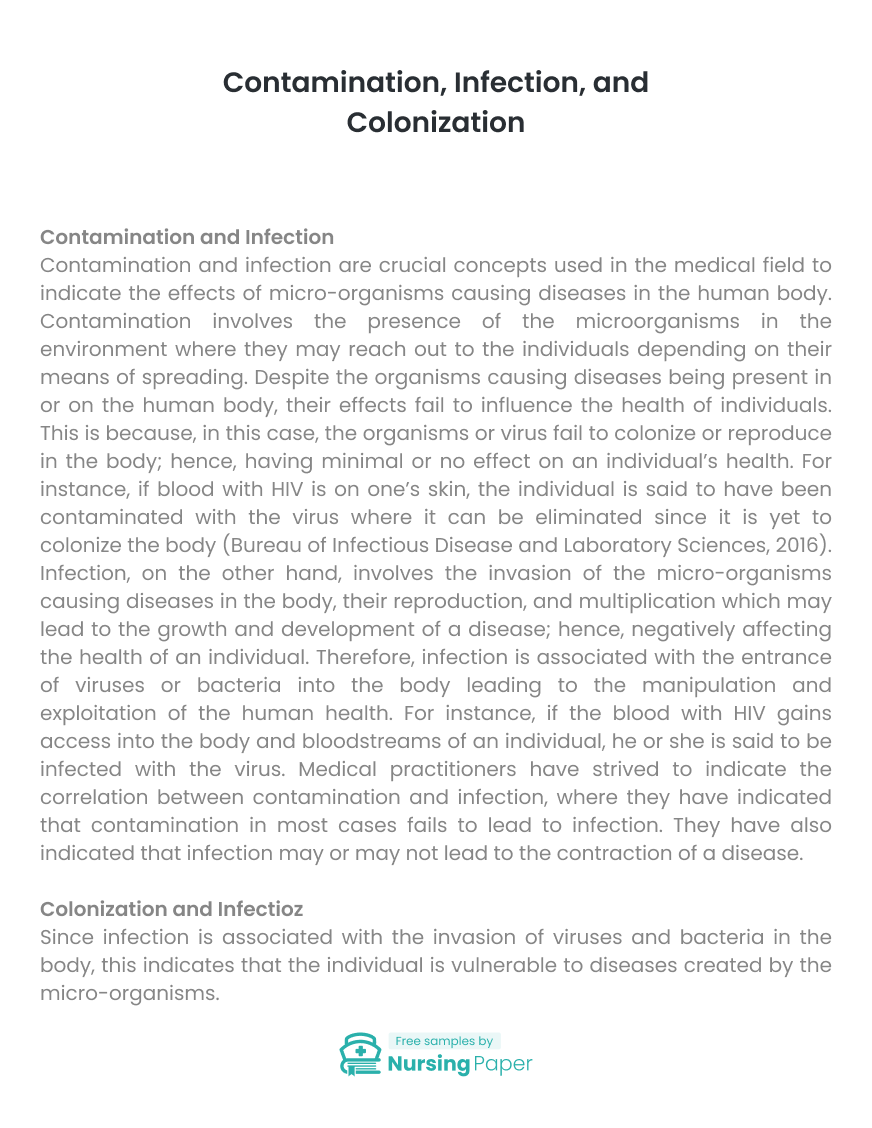
Contamination, Infection, and Colonization
Contamination and Infection
Contamination and infection are crucial concepts used in the medical field to indicate the effects of micro-organisms causing diseases in the human body. Contamination involves the presence of the microorganisms in the environment where they may reach out to the individuals depending on their means of spreading. Despite the organisms causing diseases being present in or on the human body, their effects fail to influence the health of individuals. This is because, in this case, the organisms or virus fail to colonize or reproduce in the body; hence, having minimal or no effect on an individual’s health. For instance, if blood with HIV is on one’s skin, the individual is said to have been contaminated with the virus where it can be eliminated since it is yet to colonize the body (Bureau of Infectious Disease and Laboratory Sciences, 2016). Infection, on the other hand, involves the invasion of the micro-organisms causing diseases in the body, their reproduction, and multiplication which may lead to the growth and development of a disease; hence, negatively affecting the health of an individual. Therefore, infection is associated with the entrance of viruses or bacteria into the body leading to the manipulation and exploitation of the human health. For instance, if the blood with HIV gains access into the body and bloodstreams of an individual, he or she is said to be infected with the virus. Medical practitioners have strived to indicate the correlation between contamination and infection, where they have indicated that contamination in most cases fails to lead to infection. They have also indicated that infection may or may not lead to the contraction of a disease.
Colonization and Infection
Since infection is associated with the invasion of viruses and bacteria in the body, this indicates that the individual is vulnerable to diseases created by the micro-organisms. This invasion may facilitate the reproduction and multiplication of the viruses and bacteria in the blood streams; hence, promoting the emergence of diseases in the body (Safdar & Bradley, 2008). The growth and development of the micro-organisms influence the creation of signs and symptoms that indicate the disease the infected individual is suffering from. For instance, a person infected with the HIV virus will begin showing some signs and symptoms of AIDS such as fever, vomiting, rashes, and rapid loss of weight. Colonization, on the other hand, involves the presence of germs and bacteria in or on the human body, but in this case, the individual fails to contract diseases (Miller, 2009). This means that the virus and bacteria will continue growing without having an impact on the health of a person where he or she feels fine. A colonized patient fails to show any signs and symptoms since the microorganisms present in the body fail to generate diseases. Therefore, the difference between an infected individual and a colonized patient is based on signs and symptoms where the infected patient will show them after contracting a disease while the colonized patient will fail to indicate them.


Recommended Treatment
Treatment involves the eradication of diseases; that is, bacteria and viruses present in both infected and colonized patients. The methods of treatment may differ since an infected individual is considered sick, where the signs and symptoms indicate his or her deteriorating health status. Therefore, the infected individuals may be treated through being provided with antibiotics that are expected to eliminate the bacteria in the body (Pathak, Creppage, Werner & Cattadori, 2010). This elimination facilitates the eradication of the diseases in the body. Colonized patients, on the other hand, are advised to utilize preventive measures to ensure they avoid the viruses and bacteria. For instance, they may use hand sanitizers before taking meals to ensure they are protected.
1. Bureau of Infectious Disease and Laboratory Sciences. (2016). INFECTION PREVENTION IN LONG TERM CARE. Multidrug Resistant Organisms. Retrieved from http://www.mass.gov/eohhs/docs/dph/cdc/infection-control/mdro-guide.pdf
2. Miller, M. (2009). Staphylococcus Aureus in the Community: Colonization Versus Infection. Retrieved from https://www.ncbi.nlm.nih.gov/pmc/articles/PMC2724739/
3. Pathak, A. K., Creppage, K. E., Werner, J. R., & Cattadori, I. M. (2010). Immune Regulation of A Chronic Bacteria Infection and Consequences for Pathogen Transmission. BMC Microbiology, 10(1), 226.
4. Safdar, N., & Bradley, E. A. (2008). The Risk of Infection after Nasal Colonization with Staphylococcus Aureus. The American Journal of Medicine, 121(4), 310-315.



The download will start shortly.

The download will start shortly.
 Subject:
Nursing
Subject:
Nursing  Number of pages: 9
Number of pages: 9  Subject:
Health and Social Care
Subject:
Health and Social Care  Number of pages: 10
Number of pages: 10  Subject:
Nursing
Subject:
Nursing  Number of pages: 2
Number of pages: 2  Subject:
Nursing
Subject:
Nursing  Number of pages: 7
Number of pages: 7  Subject:
Health and Social Care
Subject:
Health and Social Care  Number of pages: 18
Number of pages: 18  Subject:
Health and Social Care
Subject:
Health and Social Care  Number of pages: 2
Number of pages: 2  Subject:
Nursing
Subject:
Nursing  Number of pages: 3
Number of pages: 3  Subject:
Health and Social Care
Subject:
Health and Social Care  Number of pages: 3
Number of pages: 3  Subject:
Health and Social Care
Subject:
Health and Social Care  Number of pages: 2
Number of pages: 2  Subject:
Health and Social Care
Subject:
Health and Social Care  Number of pages: 4
Number of pages: 4  Subject:
Health and Social Care
Subject:
Health and Social Care  Number of pages: 4
Number of pages: 4  Subject:
Health and Social Care
Subject:
Health and Social Care  Number of pages: 3
Number of pages: 3  Subject:
Health and Social Care
Subject:
Health and Social Care  Number of pages: 2
Number of pages: 2  Subject:
Health and Social Care
Subject:
Health and Social Care  Number of pages: 5
Number of pages: 5  Subject:
Medicine
Subject:
Medicine  Number of pages: 10
Number of pages: 10 
